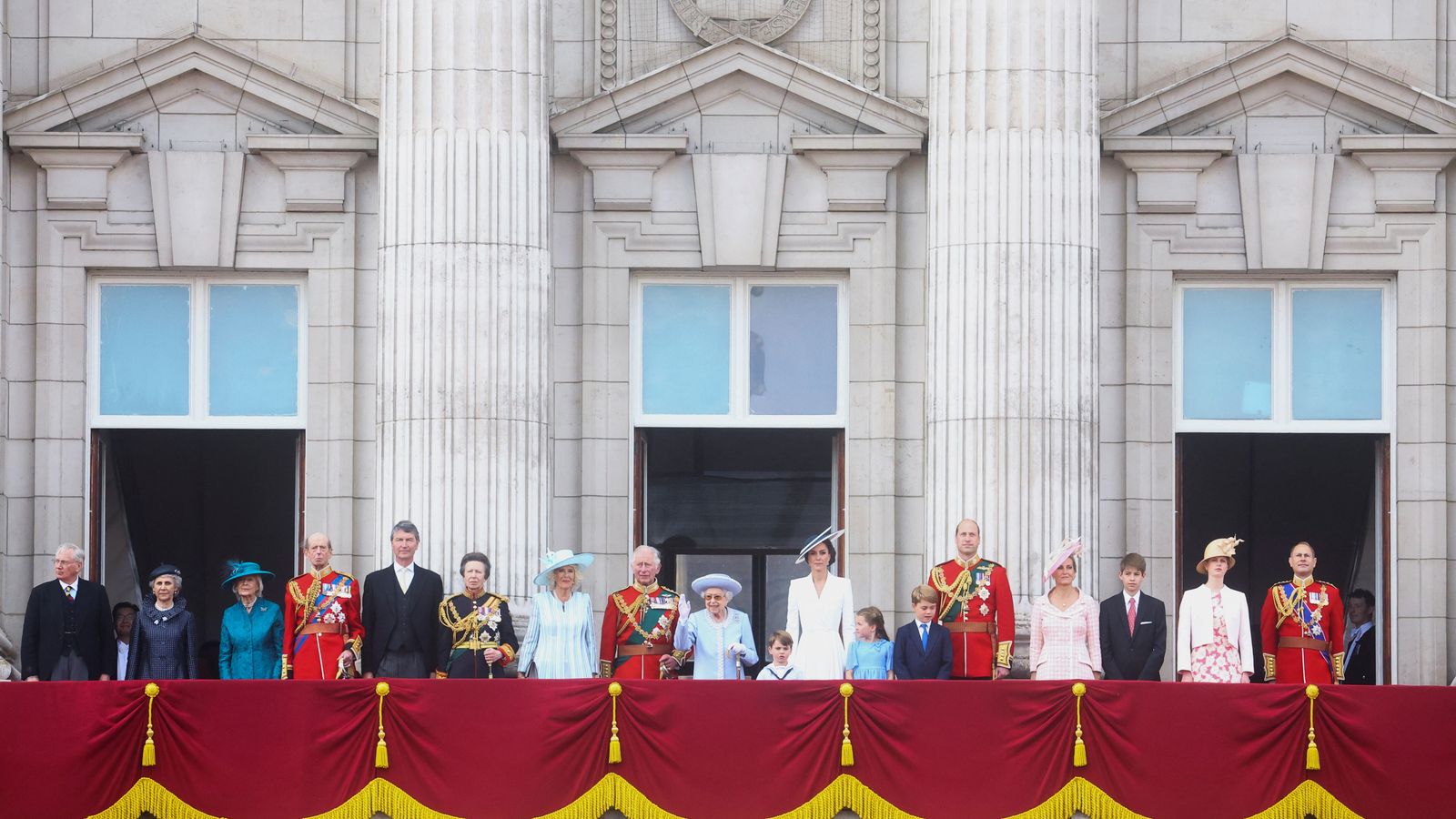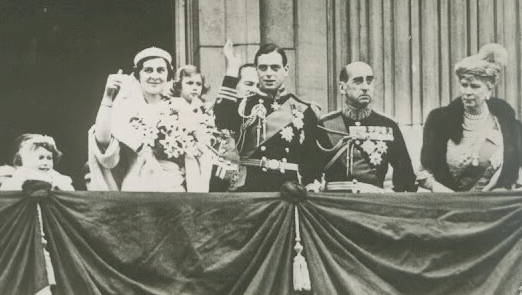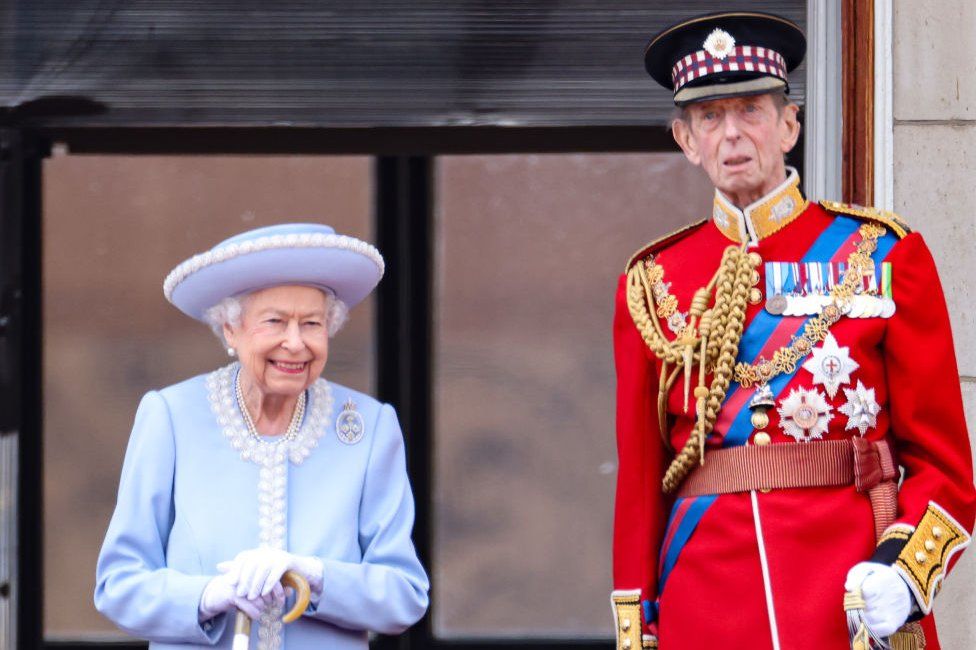The balcony of Buckingham Palace has been the focal point of royal appearances for a hundred and seventy years, seventy of which belong solely to Queen Elizabeth After the Trooping of the Colour, she once again took to the balcony as she celebrates her platinum jubilee. She is now the only British monarch to have reigned for as long and if she makes it to seventy-two years and a hundred and eleven days, she’ll become the longest-reigning monarch in the world.
She was joined on the balcony by a collection of her closest family who were present in their capacity as “working royals”. This distinction allows for the establishment to delicately sidestep the issue of Prince Andrew after his recent legal case involving his relationship with a trafficked minor, as well as Prince Harry and Meghan who apparently committed the far more unforgivable crime of moving to America.
As part of the BBC coverage of the Jubilee events, including the balcony appearance, Vanity Fair royal editor Katie Nicholl said that “you can read as much from who is in than who is out” and added that this was an opportunity for the queen to thank the family closest to her. The seventeen members of her family that joined her are all regular deputies for the queen (and their children) but some of them are a little more obscure than others and not as recognisable.
From left to right we have Prince Richard, Duke of Gloucester and Birgitte, the Duchess of Gloucester, Princess Alexandra, Prince Edward, Duke of Kent, Vice Admiral Timothy Lawrence, Princess Anne, Camilla, Duchess of Cornwall, Prince Charles, Duke of Cornwall the Queen, Catherine, Duchess of Cambridge, Prince William, Duke of Cambridge, in front we have their children Prince Louis, Princess Charlotte, and Prince George, before we resume with the Sophie, Countess of Wessex, James Viscount Severn, Lady Louise Windsor, and Prince Edward, Earl of Wessex.
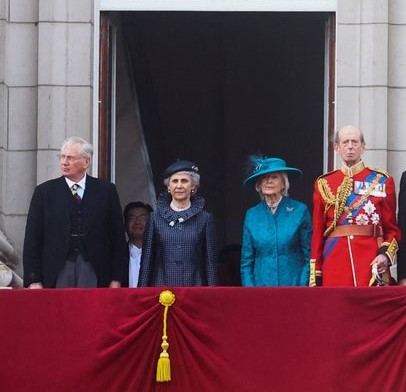
First, the Gloucesters; Prince Richard and his wife Birgitte. Prince Richard is the second son of Prince Henry who was one of the children of George V, making him the queen’s first cousin on her father’s side. Richard wasn’t expected to inherit the Dukedom from his father as he was the second son and therefore he pursued a career in architecture. In 1972 he married Birgitte Eva van Deurs Henrikson, a Danish woman he met while studying at Cambridge. Six weeks after the wedding, his elder brother died in a flying accident which saw Richard become the heir apparent to his father’s titles. He quit his job and he and Birgitte took on roles as royal deputies.
In 1974, Richard’s father Prince Henry died and Richard inherited the dukedom of Gloucester. The Gloucesters have deputised and represented the queen and Prince Philip, the Duke of Edinburgh, at many occasions worldwide. They are also known for their modest lifestyle which is partly attributed to the fact that they never expected to become as integral a part of the royal family as they did.
Princess Alexandra, the Honourable Lady Ogilvy and Prince Edward, Duke of Kent are also paternal cousins, this time through George V’s son, George. They were also maternal cousins of Prince Philip through their mother Princess Marina of Greece and Denmark. Incidentally, it was Princess Marina who began the tradition of royals waving to the public. On her wedding day in 1934, Marina and George stepped onto the same balcony where Marina waved to the people waving up to her. Until that point, the Royals had just stood awkwardly and nodded their heads, thus the royal wave was born.
Princess Alexandra is considered one of the most active members of the royal family, undertaking hundreds of appearances every year. She is known for her extensive charity work and several hospitals are named for her worldwide. Unlike many of the other royals, she doesn’t live in Kensington Palace though she has access to a grace-and-favour apartment in St. James Palace. Instead, she lives in Thatched House Lodge in Richmond. Her presence there makes the Lodge the property of the Crown but because it was acquired privately by her late husband it isn’t maintained by the Crown and can be sold on the private market.
Prince Edward has deputised for the queen for over fifty years but has also engaged in more royal appearances than any other member of the royal family in part because he inherited his father’s titles when he was just six years old. Since the death of the queen’s husband, Prince Edward has been the one to accompany the queen to royal functions as her escort. The arrangement works well as Edward’s wife, Katharine, Duchess of Kent has taken a reduced role since 2002. She is known for converting to Roman Catholicism but because she was Anglican at the time of her marriage, her husband was not required to give up his position in the line of succession. Their son, Lord Nicholas Windsor, however, forfeited his place upon his own conversion in 2001.
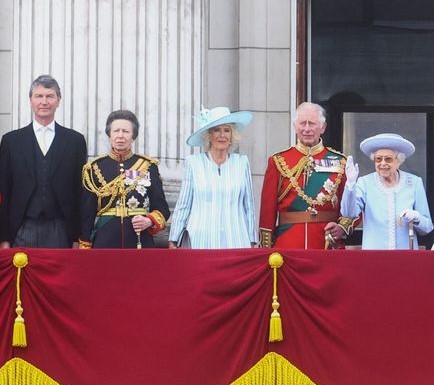
Princess Anne, the queen’s second child and only daughter, attended the Trooping of the Colour with her brother, Prince Charles, and the two rushed up to the balcony to join the rest of the family before the last guards had marched off. As the queen’s daughter, Anne falls behind her younger brothers in the line of succession and the act of Parliament that allows women to inherit regardless of their male relatives doesn’t apply to her.
Anne’s husband, Sir Timothy Laurence arrived separately in one of the royal carriages. The two met when Sir Timothy acted as equerry for the queen in 1986 while Anne was still married to Captain Mark Phillips. The marriage was rumoured to have already broken down and letters obtained in 1989 revealed that the two had been having an affair for some time. The two separated and then divorced in April 1992, allowing Anne and Sir Timothy to marry in December of the same year.
Because the Church of England didn’t allow remarriage between divorcees, the two had to go to Scotland and the queen didn’t attend. Charles faced a similar issue when he came to marry his long time lover, Camilla Shand. Camilla and Charles were both divorcees but the issue of remarriage hit harder given that Charles, as heir apparent, will one day be the head of the church that prohibits it.
Public opinion wasn’t wholly enthusiastic for the marriage. Charles’ popularity had never fully recovered from his divorce from Princess Diana and her untimely death. Neither had Charles and Camilla ever won public favour for their affair which contributed to the breakdown of Charles’ first marriage in the first place. Ultimately, after objections were levied and protests considered, Charles and Camilla were married in a civil service in Windsor’s Guildhall. Once again, the queen wasn’t present but she did attend the church blessing that followed it.
After the wedding came the more pressing issue of Camilla’s title. If elements of the public would oppose the wedding in memory of Princess Diana, creating Camilla the Princess of Wales was inviting criticism. Even though Camilla is technically the Princess of Wales by dint of her marriage to the Prince of Wales, she has never used the title. The couple have instead gone by the titles given to them for the occasion of their marriage; the Duke and Duchess of Cornwall.
There remains some question over what Camilla’s title will be if Charles inherits the crown. On the 6th of February, the date of the queen’s actual jubilee, she issued a statement in which she conveyed her wishes that when Charles becomes King, Camilla takes the title of Queen Consort.
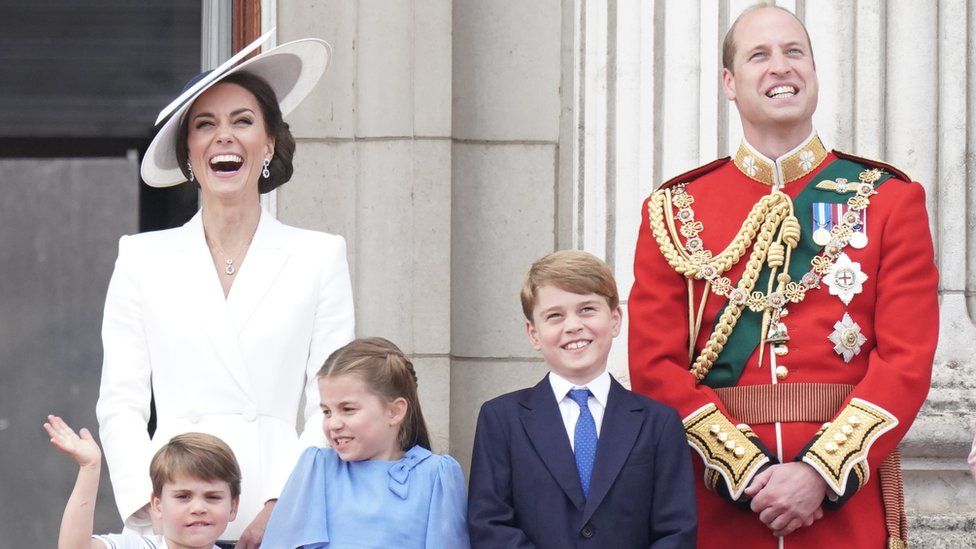
The Cambridges are among the more recognisable royals who appeared on the balcony. Even though Prince Charles is the heir apparent, his advanced age and the longevity of his mother’s life has allowed years of speculation that Charles may well never accede and instead, the crown will pass to his eldest son by Princess Diana; Prince William. To that end, William and his wife, Catherine, are often paraded as the future of the monarchy, even more so after the birth of their son George, third in the line of succession.
Elements of the press have speculated that the platinum jubilee is a means of transitioning from the queen to Prince Charles and Prince William, passing on the royal duties to allow the queen to step back from public life but in reality, this is a process that has been going on for many years already. Charles and William have been increasingly taking on the more visible aspects of the queen’s role such as the opening of Parliament and as the queen continues to struggle with mobility, we can assume that soon they will become the mainstay of the monarchy with the queen only present at very few and specific events.
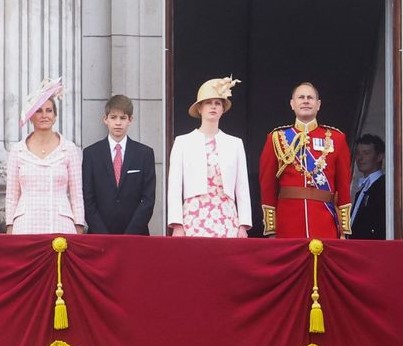
Prince Edward is the youngest of the queen’s children and the only one to have not been created a royal duke. Upon his marriage to Sophie in 1999, he was invested as the Earl of Wessex but the queen intended to give him his father’s title, Duke of Edinburgh, after Philip’s death. After his death in 2021 however, the title transferred to Prince Charles.
Edward and Sophie undertake a number of royal engagements together and separately, often representing the queen abroad. Their children; eighteen-year-old Louise and fourteen-year-old James are the only ones of the queen’s grandchildren not to have the title Princess or Prince. They are styled as children of an Earl rather than a Prince, and James uses one of his father’s secondary titles; Viscount Severn as a courtesy. Because of their ages, they have yet to embark upon the usual royal tours expected of the royal family, but they will be allowed greater freedom in that they can choose whether or not they’re going to maintain their titles when they’re eighteen.
If you’d like to join me for more fun and games in picking apart history, and other behind the scene tangents, you can support me via my Patreon.


